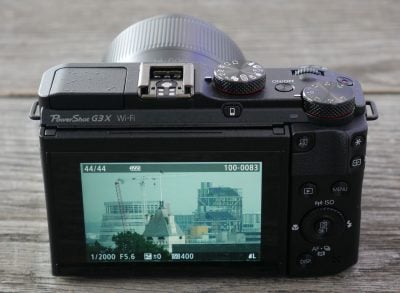Canon PowerShot G3X review
-
-
Written by Ken McMahon
Samples
Canon PowerShot G3X vs Panasonic Lumix FZ1000 JPEG quality results
To compare real-life performance, I shot this scene with the Canon PowerShot G3X and the Panasonic Lumix FZ1000 within a few moments of each other, using their best quality JPEG settings and at their base sensitivity settings. Both cameras were set to their maximum wide angle setting. At 25mm equivalent, the Lumix FZ1000 has a slightly narrower field of view than the 24mm Canon G3X. In practice, however, the difference is quite small and it proved impractical to zoom the G3X in by such a small amount.
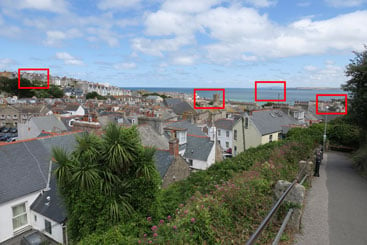
For this test the cameras were mounted on a tripod and image stabilisation was disabled. The ISO sensitivity was manually set to the lowest available standard setting and for these wide angle shots both models were set to f4 in aperture priority mode. All other settings were left on the defaults. Scroll down the page to see results with the lenses zoomed in.
Overall the results from the Canon G3X are pretty good. There’s a fair amount of detail – certainly more than you’d see from a typical compact with a smaller 1/2.3in sensor and the results are fairly consistent across the frame, though there is a tiny bit of softness creeping in at the edges.
The 1 inch sensor in the G3X is almost certainly the same Sony Sensor employed in the Lumix FZ1000 (and the Sony RX10 Mark 1) so, it’s no great surprise that the crops from the Lumix FZ1000 alongside look very similar. Looking closely at the crops, I think there’s a tiny bit more detail in the first one from the Lumix FZ1000 though. In the roofs of the two houses on the left of the crop, the fascia board and windows of the house are more clearly defined in the FZ1000 crop on the right. I also think the second Lumix FZ1000 crop looks a tiny bit sharper, but the Canon G3X does better in the third crop with the distant lighthouse more clearly rendered. There’s not much difference in the fourth crop, the G3X looks a little more grainy and some elements in the Lumiz FZ1000 crop look sharper, but there’s more detail in the roof on the Canon G3X crop. I think that at best you could say the Lumix FZ1000 lens performs slightly better than the Canon G3X at this focal length.

Above left: Canon PowerShot G3X at 8.8mm (24mm equivalent) f4, 125 ISO. Above right: Panasonic Lumix FZ1000 at 9.1mm (25mm equivalent) f4, 125 ISO.

Above left: Canon PowerShot G3X at 8.8mm (24mm equivalent) f4, 125 ISO. Above right: Panasonic Lumix FZ1000 at 9.1mm (25mm equivalent) f4, 125 ISO.

Above left: Canon PowerShot G3X at 8.8mm (24mm equivalent) f4, 125 ISO. Above right: Panasonic Lumix FZ1000 at 9.1mm (25mm equivalent) f4, 125 ISO.

Above left: Canon PowerShot G3X at 8.8mm (24mm equivalent) f4, 125 ISO. Above right: Panasonic Lumix FZ1000 at 9.1mm (25mm equivalent) f4, 125 ISO.
Canon PowerShot G3X vs Panasonic Lumix FZ1000 at 400mm
For my next test I zoomed both cameras in to 400mm equivalent. This is the maximum zoom range on the Lumix FZ1000, but it’s around around two thirds of the full zoom range on the Canon G3X. As before, I used aperture priority mode and set both models to f5.6. At this focal length there’s a little bit of distortion caused by the warm air between the camera and subject, but as before it’s very difficult to separate the crops from the two cameras in terms of quality. At this focal length I think the Canon may be ever so slightly sharper on the basis of the second and third crops, from closer to the middle of the frame, but it’s a very marginal performance edge.
Scroll down further to see how the Canon performs when zoomed to 600mm.
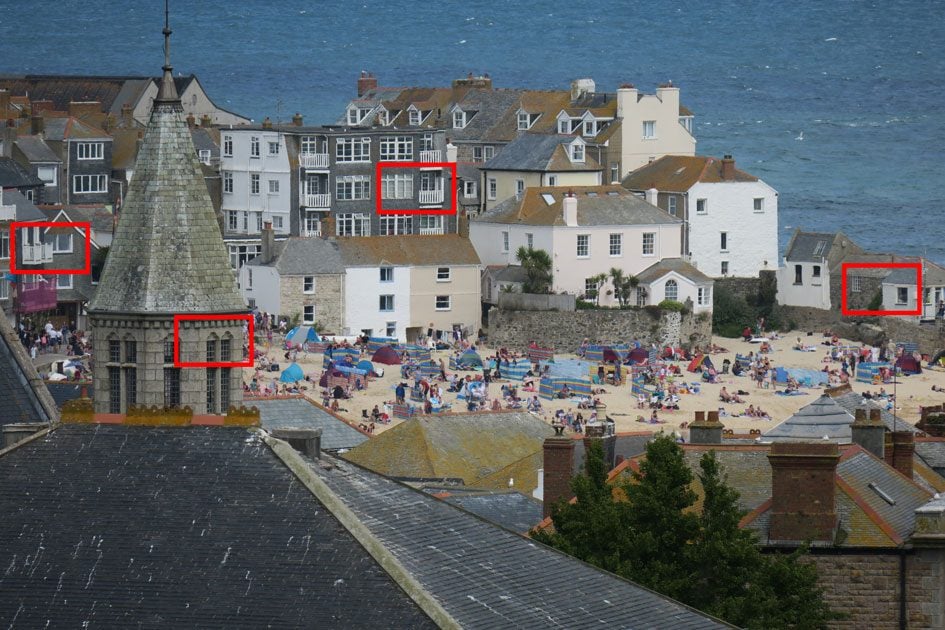

Above left: Canon PowerShot G3X at 147mm (400mm equivalent) f5.6, 125 ISO. Above right: Panasonic Lumix FZ1000 at 146mm (400mm equivalent)f5.6, 125 ISO.

Above left: Canon PowerShot G3X at 147mm (400mm equivalent) f5.6, 125 ISO. Above right: Panasonic Lumix FZ1000 at 146mm (400mm equivalent)f5.6, 125 ISO.

Above left: Canon PowerShot G3X at 147mm (400mm equivalent) f5.6, 125 ISO. Above right: Panasonic Lumix FZ1000 at 146mm (400mm equivalent)f5.6, 125 ISO.

Above left: Canon PowerShot G3X at 147mm (400mm equivalent) f5.6, 125 ISO. Above right: Panasonic Lumix FZ1000 at 146mm (400mm equivalent)f5.6, 125 ISO.
Canon PowerShot G3X quality at 600mm
Finally here’s a set of crops from the Canon G3X zoomed in to its maximum 600mm equivalent focal length. As before, the lens was set to f5.6, the widest available aperture when fully zoomed in. There are no comparison crops from the Lumix FZ1000 which stops at 400mm equivalent. Once again there’s some distortion caused by the refractive properties of the warm air between the camera lens and the subject, but despite that I think the lens performs as well at the maximum 600mm focal length as it did at 400mm. There’s plenty of detail in the brickwork in the first crop and the roof tiles in the second . One thing you can spot here which isn’t evident in the earlier crops is chromatic aberration. The purple fringing that results is most noticeable in the first and last crops – from closest to the edge of the frame. It’s not too bad, though, no doubt as a result of in-camera correction.
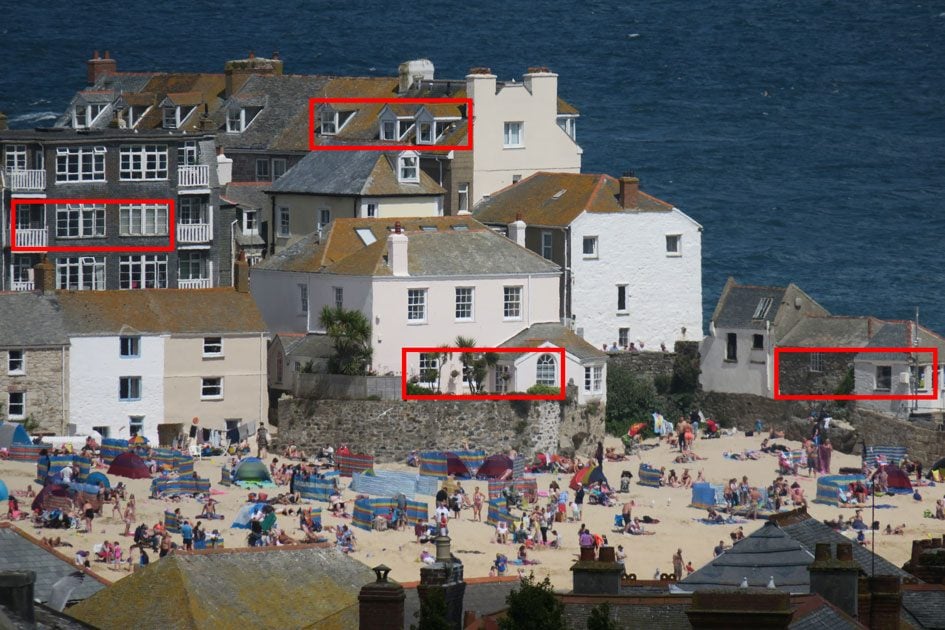

Above: Canon PowerShot G3X at 220mm (600mm equivalent) f5.6, 125 ISO

Above: Canon PowerShot G3X at 220mm (600mm equivalent) f5.6, 125 ISO

Above: Canon PowerShot G3X at 220mm (600mm equivalent) f5.6, 125 ISO

Above: Canon PowerShot G3X at 220mm (600mm equivalent) f5.6, 125 ISO
Canon PowerShot G3X vs Panasonic Lumix FZ1000 RAW quality results
To compare real-life RAW performance, I shot this scene with the Canon PowerShot G3X and the Panasonic Lumix FZ1000 within a few moments of each other, using their RAW settings and at their base sensitivity settings. Both cameras were set to their maximum wide angle setting. At 25mm equivalent, the Lumix FZ1000 has a slightly narrower field of view than the 24mm Canon GX3. In practice, however, the difference is quite small and it proved impractical to zoom the GX3 in by such a small amount.
For this test the cameras were mounted on a tripod and image stabilisation was disabled . The ISO sensitivity was manually set to the lowest available standard setting and for these wide angle shots both models were set to f4 in aperture priority mode. All other settings were left on the defaults. scroll down the page to see results with the lenses zoomed in.
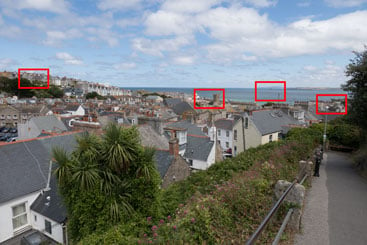
I processed both files in Adobe Camera RAW using identical settings: Sharpening at 50 / 0.5 / 36 / 10, Luminance and Colour Noise Reduction both set to zero, the White Balance set to 5600K and the Process to 2012 with the Adobe Standard profile. These settings were chosen to reveal the differences in sensor quality and isolate them from in-camera processing. The high degree of sharpening with a small radius enhances the finest details without causing undesirable artefacts, while the zero noise reduction unveils what’s really going on behind the scenes.
There are two things to take away from this comparison of the RAW output from the Canon G3X and Lumix FZ1000. The first is that, judging by these RAW crops, both cameras do a pretty good job of producing JPEG files, so if you were hoping to squeeze better quality images from the RAW files than those produced in-camera you’re going to have a job on your hands. That’s not to say that you won’t be able to take advantage of the RAW data to give you more latitude when it comes to making exposure and colour corrections though, so it’s a feature that’s still very much worth having.
The second thing is that there’s very little to separate these two models when it comes to image quality. Despite small exposure and lighting differences (despite the exact same exposure settings the Canon G3X crops look a little lighter) all of the crops look near identical.
Now to find out how how they compare at higher sensitivities in my Canon PowerShot G3X noise results, or skip to my Canon PowerShot G3X sample images, or head straight to my verdict.

Above left: Canon PowerShot G3X at 8.8mm (24mm equivalent) f4, 125 ISO. Above right: Panasonic Lumix FZ1000 at 9.1mm (25mm equivalent) f4, 125 ISO.

Above left: Canon PowerShot G3X at 8.8mm (24mm equivalent) f4, 125 ISO. Above right: Panasonic Lumix FZ1000 at 9.1mm (25mm equivalent) f4, 125 ISO.

Above left: Canon PowerShot G3X at 8.8mm (24mm equivalent) f4, 125 ISO. Above right: Panasonic Lumix FZ1000 at 9.1mm (25mm equivalent) f4, 125 ISO.

Above left: Canon PowerShot G3X at 8.8mm (24mm equivalent) f4, 125 ISO. Above right: Panasonic Lumix FZ1000 at 9.1mm (25mm equivalent) f4, 125 ISO.
Canon PowerShot G3X vs Lumix FZ1000 noise JPEG
To compare noise levels under real-life conditions, I shot this scene with the Canon PowerShot G3X and the Panasonic Lumix FZ1000 within a few moments of each other at each of their ISO settings. Both cameras were set to their best quality JPEG modes and mounted on a tripod. Stabilisation was disabled, but otherwise the cameras were left on their default settings.
Both cameras were set to their maximum wide angle setting. At 25mm equivalent, the Lumix FZ1000 has a slightly narrower field of view than the 24mm Canon GX3. In practice, however, the difference is quite small and it proved impractical to zoom the GX3 in by such a small amount.
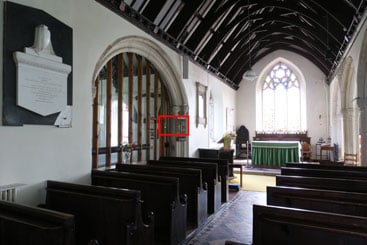
Both cameras were set to f4 in aperture priority mode. To obtain the same exposure on both cameras it was necessary to set +1EV exposure compensation on the Canon G3X to match the 1/2s exposure metered by the Lumix FZ1000 at 125 ISO. Note that the Lumix FZ1000 sensitivity range can be exended providing 80, 100 and 25600 ISO settings in addition to the standard 125-12800 ISO range and I’ve included these for the sake of completeness. I took crops from each ISO setting from each camera and have presented them below at 100%; the cropped area is marked by a red rectangle on the image above.
Despite the fact that the exposure is the same the Canon G3X crops are a little brighter than those from the Lumix FZ1000. Both of these models employ a 1 inch 20 Megapixel CMOS sensor and in all likelihood it’s the same one, so you wouldn’t expect to see too much of a difference in the noise levels and at the lower ISO sensitivity settings that’s certainly the case. Comparisons aside though, it’s worth pointing out that the noise levels right the way through the sensitivity range are significantly lower than you’d get with a typical 1/2.3in compact sensor.
The 125 and 200 ISO settings are nice and clean and I can’t see a great deal of difference between them. At 400 ISO both crops are looking a tiny bit granier but it’s not unpleasant and it’s not affecting the image detail. Interestingly, at 800 ISO the Canon G3X crop looks a tiny bit grainier than the FZ1000 one and there’s a definite gap opening up at 1600 ISO. From there on up to 12800 ISO the crops from the Lumix FZ1000 look less noisy, so whether it’s better noise suppression or some other factor or work a little bit of a surprise result that sees the Lumix FZ1000 coming out on top for noise performance when shooting JPEGs. Next check out my Canon G3X RAW noise results. Or skip to my Canon G3X sample images, or head straight to my verdict.

Above left: Canon PowerShot G3X 80 ISO not available. Above right: Panasonic Lumix FZ1000 at 80 ISO.

Above left: Canon PowerShot G3X 100 ISO not available. Above right: Panasonic Lumix FZ1000 at 100 ISO.

Above left: Canon PowerShot G3X at 125 ISO. Above right: Panasonic Lumix FZ1000 at 125 ISO.

Above left: Canon PowerShot G3X at 200 ISO. Above right: Panasonic Lumix FZ1000 at 200 ISO.

Above left: Canon PowerShot G3X at 400 ISO. Above right: Panasonic Lumix FZ1000 at 400 ISO.

Above left: Canon PowerShot G3X at 800 ISO. Above right: Panasonic Lumix FZ1000 at 800 ISO.

Above left: Canon PowerShot G3X at 1600 ISO. Above right: Panasonic Lumix FZ1000 at 1600 ISO.

Above left: Canon PowerShot G3X at 3200 ISO. Above right: Panasonic Lumix FZ1000 at 3200 ISO.

Above left: Canon PowerShot G3X at 6400 ISO. Above right: Panasonic Lumix FZ1000 at 6400 ISO.

Above left: Canon PowerShot G3X at 12800 ISO. Above right: Panasonic Lumix FZ1000 at 12800 ISO.

Above left: Canon PowerShot G3X 25600 ISO not available. Above right: Panasonic Lumix FZ1000 at 25600 ISO.
Canon PowerShot G3X vs Lumix FZ1000 noise RAW
To compare RAW noise levels under real-life conditions, I shot this scene with the Canon PowerShot G3X and the Panasonic Lumix FZ1000 within a few moments of each other at each of their ISO settings. Both cameras were set to their RAW modes and mounted on a tripod. Stabilisation was disabled, but otherwise the cameras were left on their default settings.
Both cameras were set to their maximum wide angle setting. At 25mm equivalent, the Lumix FZ1000 has a slightly narrower field of view than the 24mm Canon GX3. In practice, however, the difference is quite small and it proved impractical to zoom the GX3 in by such a small amount.
Both cameras were set to f4 in aperture priority mode. To obtain the same exposure on both cameras it was necessary to set +1EV exposure compensation on the Canon G3X to match the 1/2s exposure metered by the Lumix FZ1000 at 125 ISO. Note that the Lumix FZ1000 sensitivity range can be exended providing 80, 125 and 25600 ISO settings in addition to the standard 125-12800 ISO range and I’ve included these for the sake of completeness. I took crops from each ISO setting from each camera and have presented them below at 100%; the cropped area is marked by a red rectangle on the image above.
I processed all files in Adobe Camera RAW using identical settings: Sharpening at 50 / 0.5 / 36 / 10, Luminance and Colour Noise Reduction both set to zero, the White Balance set to 4000K and the Process to 2012 with the Adobe Standard profile. These settings were chosen to reveal the differences in sensor quality and isolate them from in-camera processing. The high degree of sharpening with a small radius enhances the finest details without causing undesirable artefacts, while the zero noise reduction unveils what’s really going on behind the scenes – as such the visible noise levels at higher ISOs will be much greater than you’re used to seeing in many comparisons, but again it’s an approach that’s designed to show the actual detail that’s being recorded before you start work on processing and cleaning it up if desired.
These RAW crops tell us something that you might already have expected; there’s very little difference in the noise performance of these two models. with the exception of the slight difference in brightness levels the two sets of crops are near identical. Both show reasonably low levels of noise up to 1600 ISO and then marked linear increases all the way up to the maximum 12800 Setting.
In My JPEG noise test, the G3X fared a little worse than the Lumix FZ1000 at the higher ISO sensitivity settings. High ISO Noise reduction has three settings on the G3X and is set to the middle Standard setting by default, so you could experiment with that when shooting JPEGs or alternatively there’s doubtless room for some improvement when processing the RAW files.

Above left: Canon PowerShot G3X 80 ISO not available. Above right: Panasonic Lumix FZ1000 at 80 ISO

Above left: Canon PowerShot G3X 100 ISO not available. Above right: Panasonic Lumix FZ1000 at 100 ISO

Above left: Canon PowerShot G3X at 125 ISO. Above right: Panasonic Lumix FZ1000 at 125 ISO

Above left: Canon PowerShot G3X at 200 ISO. Above right: Panasonic Lumix FZ1000 at 200 ISO

Above left: Canon PowerShot G3X at 400 ISO. Above right: Panasonic Lumix FZ1000 at 400 ISO

Above left: Canon PowerShot G3X at 800 ISO. Above right: Panasonic Lumix FZ1000 at 800 ISO

Above left: Canon PowerShot G3X at 1600 ISO. Above right: Panasonic Lumix FZ1000 at 1600 ISO

Above left: Canon PowerShot G3X at 3200 ISO. Above right: Panasonic Lumix FZ1000 at 3200 ISO

Above left: Canon PowerShot G3X at 6400 ISO. Above right: Panasonic Lumix FZ1000 at 6400 ISO

Above left: Canon PowerShot G3X at 12800 ISO. Above right: Panasonic Lumix FZ1000 at 12800 ISO

Above left: Canon PowerShot G3X 25600 ISO not available. Above right: Panasonic Lumix FZ1000 at 25600 ISO




